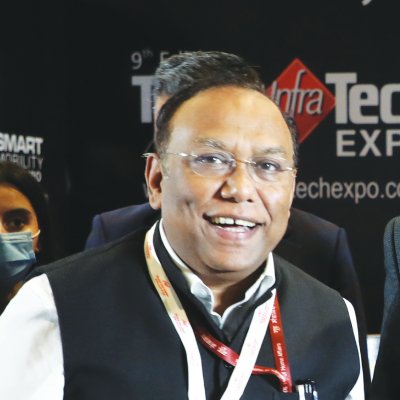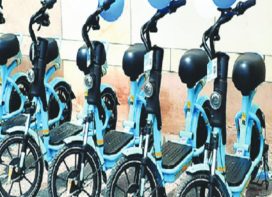
Amit Kumar Ghosh, Additional Secretary, Highways, MoRTH
In an exhaustive interview with Trafficinfratech, Amit Kumar Ghosh, Additional Secretary, Highways, MoRTH lists out the multitude of projects being undertaken by the Government. According to him, reducing vehicular pollution and moving towards sustainable development should be the top priority areas.
The Government has allocated Rs 111 lakh crore (US$ 1.4 trillion) under the National Infrastructure Pipeline (NIP) for 2019–25. When it comes to highway and corridor development, what do you think the priorities should be?
We have adopted an integrated development approach across departments under the aegis of the Prime Minister’s Gati Shakti Plan. Thirty-five logistics parks have been identified for development to cater to key production and consumption centres accounting for 50% of India’s road freight. Intermodal stations are to be developed in 15 cities to ease passenger movement. These logistics parks and intermodal stations will address key issues such as unfavourable modal mix, inefficient fleet mix and underdeveloped material-handling infrastructure.
The National Highway network is to be expanded as a part of the Rs. 5.35 lakh crore Bharatmala Pariyojana project, which aims to connect over 700 nodes in the country. Further, there will be planned interconnection between economic corridors, first mile and last mile connectivity for 15,400km. Moreover, the identified connectivity to border areas and neighbouring countries (5,198km), and connectivity to coastal areas to enable port-led economic development (3,298km) are to be executed.
To facilitate unhindered flow of freight and passengers, access-controlled corridors are being conceptualized. Twenty-four greenfield expressways and access-controlled corridors with a cumulative length of more than 7,000km are being planned as a part of the Bharatmala Pariyojana project Phase-1, with design speeds of 120kmph and 100kmph. A country-wide rollout of the Integrated Road Accident Database has been done, with tablets in all police stations for recording real-time accident data to enable policy interventions.
Reducing vehicular pollution and moving towards sustainable development should be top priority areas. This can be done through increased adoption of alternate fuels and cutting-edge technologies. In the Delhi–Mumbai greenfield expressway project, we envision these benefits: (i) compensatory afforestation of 10 lakh trees; (ii) reduction in travel time by ten hours; (iii) net fuel savings of 1,976 lakh litres/year; and (iv) reduction in carbon dioxide emissions by ~53 crore kg/year.
We are also streamlining pre-construction activities. The land acquisition process is being eased out through frequent review and coordination discussions with State Governments, and exercising due diligence in finalizing agreements to ensure minimal disruption to settlements. An integrated approach has been initiated to accelerate obtaining approvals such as environmental, forest and wildlife clearances, road over bridge constructions, utility shifting agencies such as Ministry of Environment, Forest and Climate Change, Ministry of Railways, Ministry of Power and various State agencies.

There is a requirement for high quality technology, material and construction processes for road development…
In terms of improving quality, we are using modern construction equipment such as the world’s widest paver of 18.75 m deployed in the Delhi–Mumbai expressway project. We have adopted latest construction practices such as the New Austrian Tunnelling Method (NATM) in tunnel projects. To maximize the lifetime of expressways, we have employed an innovative perpetual pavement design.
The Indian Roads Congress (IRC) has come up with guidelines for the use of cement-treated base (CTB), cement treated sub-base (CTSB), waste plastic, geo-synthetics, fly ash and crumb rubber modified bitumen (CRMB) for soil stabilization and recycling in highway construction in 2020. The IRC has also accredited new materials, techniques, equipment and products, which can be used as per prescribed codes, guidelines and circulars. All the regional officers of the MoRTH, NHAI and National Highways and Infrastructure Development Corporation (NHIDCL), and the CEs of Border Roads Organisation are encouraged to use new and alternative materials and technologies.
To identify areas where quality improvement is required, a satellite mapping of corridors was conducted in more than 13,000km of roads to identify upgradation requirements such as lane expansion and decongestion of existing National Corridors). A dedicated Quality Control Zone (QCZ) has been setup in the Ministry to prepare policy guidelines, issue directions and suggestions for system improvement, and for quality assurance/control on works pertaining to National Highways. The QCZ is also empowered to inspect records and documents related to any project of the Ministry, NHAI, NHIDCL and BRO.
To monitor and control the quality of construction, network survey vehicles and laser profilometers are being deployed. A highway corridor rating has been defined to rate road user experience on parameters such as ride quality, safety and amenities.
To improve safety, an intelligent traffic management system has been executed in all new projects. It is in the final stage of execution in the Delhi–Meerut Expressway, Mukarba Chowk–Panipat section and Eastern Peripheral Expressway. It is part of the new Delhi–Mumbai greenfield expressway contract. In completed projects, where ITMS was not a part, NHAI is issuing separate request for proposals (RFPs). The target is to complete 1000 km by 2021 and the complete length of 4/6 lane National Highways by 2024.
We are developing an integrated road accident database (iRAD) for recording real-time accident data. The Indian Institute of Technology Madras and National Informatics Centre Services Inc. have been asked to design, develop and implement the iRAD software and plan its roll-out initially in six pilot states namely Maharashtra, Karnataka, Madhya Pradesh, Rajasthan, Uttar Pradesh and Tamil Nadu.
Advanced traffic management systems are to be installed in all new greenfield corridors. The implementation of access control in greenfield expressways and National Highways (more than 7,000km) has improved road safety due to reduced/negligible cross traffic. Through road safety audits (more than 32,000 km), 5,785 blackspots were identified, and 73% of them have been attended to by swift design interventions.
Often, developers and system providers find it difficult to keep pace with the specifications and standards set by the Government. How is this addressed?
The standards with respect to roads are formulated by IRC, which is a society that includes all stakeholders such as the Government (Central and State), research institutions, concessionaires, contractors, consultants, equipment manufacturers, local bodies, industry associations, suppliers and multilateral institutions. The Executive Committee of the IRC, which is the decision-making body, includes representatives from all stakeholder groups. The IRC conducts detailed consultations with all stakeholder groups, and invites their comments/suggestions on all codes/standards before and even after publication.
Further, MoRTH conducts extensive consultations with developer groups and system providers such as the National Highways Builders Federation (NHBF). Technology recommendations and suggestions are translated into policy decisions only after such consultations.
To promote a domestic contractor ecosystem, modifications have been made in RFQs and the qualification criteria streamlined. This facilitated increased private sector participation, and the average number of bids per project increased from 15/project to 30/project. To resolve any financial constraints that developers might face in executing projects, MoRTH and NHAI worked together to:
(i) settle bills within specified time; (ii) issue bids, excluding the goods and services tax (GST) as part of the quoted bids; and (iii) set up a system of conciliation. MoRTH has also improved contractor liquidity through monthly payment, reducing performance security and release of retention money.
Tolling technology has also been changing. Can you give details about the plan for GPS-based tolling? How will this be integrated with the existing toll collection systems?
Leveraging technology in toll collection has improved efficiency and transparency, and increased investors’ confidence in road infrastructure projects. The success of RFID-based Electronic Toll Collection (ETC) has already been appreciated by all stakeholders. To further augment and improve toll collection—whereby a highway user has to pay only for travel on the NH, instead of a fixed distance rate—the Ministry has envisaged to implement a satellite-based toll collection system within 1 to 2 years.
FASTag offers multiple utilities such as parking payments, fuel charges and insurance. Hence, an attempt will be made to integrate both systems whereby the payment model of satellite-based tolling can use FASTag.

There are multiple projects across India with a common vision to have smart mobility. Can you highlight some unique projects that would make a difference?
The Transport Section is administering a scheme called ‘Central assistance for Strengthening ITS in Public Transport System’ to improve the quality and quantity of public transport services in the country. This will improve reliability, journey time, accessibility and information. Under this scheme, financial assistance will be provided to States for
- introducing/upgrading technologies such as GPS/GSM-based real-time vehicle tracking system, dynamic Passenger Information System (PIS), and advanced display and communication technologies.
- improving customer focus. This will involve capturing data on things that matter to customers, journey planning, real-time information sharing, gathering feedback from customers through various channels on staff behaviour, vehicle condition and driving, grievances and their resolution.
- automatic fare collection system in buses through the National Common Mobility Card (smart card) and inter-modal fare integration for services covering inter-city and mofussil areas.
- real-time operational management, monitoring performance (across depots, shifts and routes), dynamic re-routing or re-scheduling, monitoring of tickets issued and amount collected.
- network management and service planning including real-time service monitoring, performance management, scheduling, development and implementation.
- development of innovative mobile apps for customer surveys, and to share information with customers. An open data policy will be used to allow these tools to be provided by third party developers.
MoRTH has issued a GSR notification for electronic monitoring and enforcement of road safety. The electronic enforcement device can be used for enforcement of traffic rules and issuance of challans thereon. These devices include speed camera, closed-circuit television camera, speed gun, body wearable camera, dashboard camera, automatic number plate recognition, weigh in machine and other technologies specified by the State Governments. These devices are to be placed in high-risk and high-density corridors on National Highways and State Highways, and at critical junctions at least in major cities.
Through multiple initiatives, the Government has been able to achieve the following with regard to smart mobility:
- More than 94% FASTag penetration across all NH toll plazas.
- Thirty-five million RFID-based FASTags issued nationwide.
- ATMSs implemented on key expressways.
- ANPR FASTag system-based multi-lane free flow tolling system piloted in Delhi–Meerut Expressway.
- Automatic generation of e-challan to traffic-rule violators. A pilot project is being implemented in the Delhi–Meerut expressway.
MoRTH is also facilitating the development of NextGen mobility support infrastructure for electric vehicles. The FAME II policy is aimed at promoting faster adoption and manufacturing of electric vehicles in India. This policy is visionary and has led to a phenomenal start to the shift towards a more environment-friendly automobile market. It has worked as a phenomenal catalyst in inviting young players with the entrepreneurial spirit to build cleaner and sustainable mobility solutions towards a better tomorrow.
In the past couple of years, the Indian Government and many private players have installed Bharat DC-001 standard EV charging stations across the country, expecting car manufacturers to follow the same protocol. The Ministry has announced that EV charging stations will be installed every 40–60 km. The initial plan is to establish these charging stations across at least 40,000 km of highways by 2023.
 TrafficInfraTech Magazine Linking People Places & Progress
TrafficInfraTech Magazine Linking People Places & Progress


